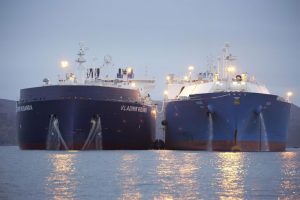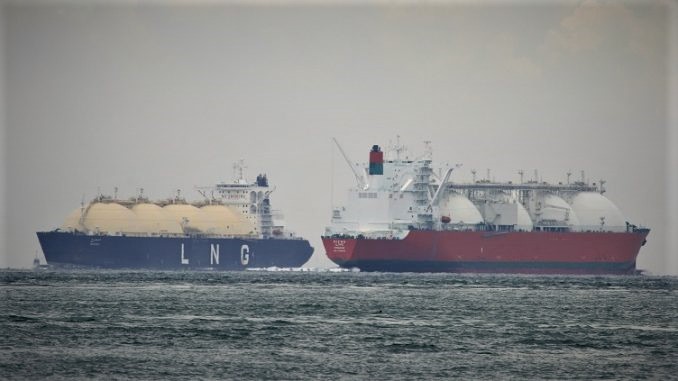Low LNG prices at around 5 USD/MMBtu and ship dayrates sustained above 100,000 USD have in 2019 put pressure on operators to find ways to optimize operations. Trading margins have effectively been wiped out and the companies bearing the fixed costs of liquefaction and shipping are under pressure.
There is now evidence that structurally significant efficiency improvement measures are under in shipping. Last year Novatek led the way with the implementation of industrial-scale ship reloading operations of Yamal LNG. Traditionally conservative Qatargas/Nakilat has started executing on a powerful model – “cabotage”, or “backhaul”.
Numbers don’t lie
Operators must improved fleet utilization to increase profit margins. Eikland Energy has analyzed actual global fleet utilization vs. modelled optimal dispatching, as well as the efficiency potential for individual operators based on actual ship programs. The result is that average improvements of 10-15% are realistic, and 30% reachable for some.
Mathematical programming has been used by oil majors in refinery operations and planning for decades. While evidence since about 2012 points to the development of more advanced LNG cargo and ship scheduling by some oil majors, Eikland Energy has identified a surprising number of remaining extreme fixed-trade and spot trade inefficiencies. It is also clear that dynamic LNG fleet scheduling, cargo and market matching is very difficult when demand deviates from plan.
Obstacles can be worked around
Seasonal variations, contractual commitments and increased short-term trading with need for commercial flexibility clearly contribute to fleet inefficiencies, However, some operators are over-chartered by more than 25% even accounting for these factors, ostensibly “for safety reasons.” Safety margins can be much lower even for conservative players by changing the shipping model. Just as in pipelines systems in developed gas markets years ago backhaul opportunities were missed.
For example, ships discharging LNG from Nigeria at Altamira on Mexico’s Gulf coast have very often moved on to load at Sabine Pass. Paradoxically, given the short sailing and the obvious swap/arbitrage opportunities, very few cargoes have been delivered from Trinidad’s Atlantic LNG. Nigeria has supplied 2x the number of cargoes to Altamira than US plants. Even accounting for LNG quality differences and ship issues it seems clear that commercial rigidities and old habits have been obstacles to change.
Enter Qatargas
There is now evidence that Qatargas, a most conservative player historically, exploring new ways of improving fleet utilization, presumably via its daughter transportation company Nakilat. This is perhaps due to new openness and scale benefits after the merger between QatarGas and Rasgas. In May 2019, Q-flex 210000 m3 Al Safliya sailed from the Tongyeong terminal in Korea through the Panama Canal to Sabine Pass where a partial cargo was loaded. The ship then sailed and offloaded at Hazira, India, via Suez, before completing the global journey at the Ras Laffan home port.
The Al Safliya formally “vetted” Q-flexes through the Panama Canal, and also in loading at Sabine Pass. Notably, however, her overall sailing distance was comparative to a conventional return to Ras Laffan, but the semi-backhaul cargo probably made the trip profitable. This Al Safliya trip was a signal of more to come.
From pilot to industrial cabotage
In late October and in November 2019, 217000 m3 Q-flex’es Al Kharsaah and Al Gharrafa picked up LNG cargoes from Sabine Pass after having discharged Qatari LNG at Zeebrugge and South Hook, respectively. Eikland Energy’s iGIS/LNG now expect them to discharge in India, Al Kharsaah at Dahej on 6 December (today at the time of this writing) and Al Gharrafa at Hazira or Dahej on 14 December.
On 12 November, the 145500 m3 Milaha Qatar offloaded its cargo at Adriatic LNG, and proceeded to load at Arzew on 25 November. The ship is now on her way through Suez and one of the two Karachi, Pakistan FSRU terminals seems a likely destination, also around 14 December. In fact Milaha Qatar and Al Gharrafa are both scheduled through Suez on 7 December.
Very large transportation savings
The Ras Laffan-Adriatic-Arzew-Karachi-RasLaffan trade is an example of almost perfect cabotage, but the business cases of the Q-flex trips to Sabine Pass are convincing too. The combined round-trip journeys between Ras Laffan and North-West Europe, and Sabine Pass and Hazira is about 32100 nautical miles. The current Al Kharsaah and Al Gharrafa trades gives a total sailing of only 22000 nautical miles.
Although the 30% saving in sailing distance is spectacular, the net effect is somewhat less in these cases since the ships were only able to load the entitlement of about 160000 m3 at Sabine Pass. However, the Sabine Pass run may in fact be a case-in-point illustration of extra system benefits for Qatargas and Exxon when their neighboring Golden Pass LNG export project starts operation in 2024.
Far-reaching implications
The Qatari cabotage schemes are very convincing and have probably already broken substantial ground internally in Qatargas and with partners. In fact, the experiences may possibly feed-back to Qatar’s ship size decisions in its current shipyard capacity reservation tenders. A forward-looking sizing strategy, based on learning from the journeys, could even be to standardize on 170-180000 m3 for new ships, simply because that is the new LNG “lot” size.
For other players the Qatari experience should be of inspiration as it separates shipping from the LNG commodity. The question is whether the model is as scalable and easily replicable. The massive savings in the Milaha Qatar, Al Kharsaah and Al Gharrafa trades are at the theoretical limit of what a completely optimized global fleet operation model would give. They are harder to replicate in a commoditized trading environment. Ship reloading may appear to be more flexible, but has additional costs and complexities, as Novatek found with its large-scale scheme at Honningsvåg, Norway from December 2018 to June 2019.
Taking the next steps
Current advanced scheduling systems as we know them do not seem to capture cabotage opportunities in the Qatargas sense. Most operators would seem to have the potential to benefit from adding or expanding the Qatari notion of cabotage in their planning. Smaller operators may see extra potential in such new cooperation-based models where they otherwise could be at a competitive disadvantage.
Many players will need to rethink their business processes. The combination of good tools and industry knowledge are as always essential in the creative process. Eikland Energy’s terminal-based, dynamic slot-level LNG dispatch model suggests a range of feasible opportunities, in part depending on partner preferences and strategy.
Summing up
2019 has seen a continued increase in LNG supply that has led to a collapse in not only LNG prices, but lowering of gas and energy prices generally and higher ship dayrates. The resultant pressure on margins has made it essential to optimize shipping, which is a key cost area that operators can control. Qatar has in important ways now broken new ground with its cabotage scheme, and similar potential is there for others as well. The unique strength of the concept is by looking beyond the conventional corporate planning silo. In fact, the LNG industry now shows that its development mirrors natural gas and power markets before.
Do not hesitate to contact Eikland Energy to discuss how our LNG cargo contract database, iGIS/LNG shipping algorithms and experienced advisory services can assist in identifying and implementing such necessary improvements.


